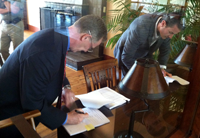OIT Signs Master Lease Agreement with AT&T
April 13, 2012
 In a major step to improve cellular service on campus, David Thurston, the Associate VP for Financial Operations (pictured on left), recently signed a Master License Agreement (MLA) with AT&T. This agreement, also signed by the Director of Business Development for AT&T, will pave the way for an AT&T-funded multi-million dollar Neutral Host Distributed Antenna System (DAS) that will provide service not only for AT&T, but for other cell phone carriers as well.
In a major step to improve cellular service on campus, David Thurston, the Associate VP for Financial Operations (pictured on left), recently signed a Master License Agreement (MLA) with AT&T. This agreement, also signed by the Director of Business Development for AT&T, will pave the way for an AT&T-funded multi-million dollar Neutral Host Distributed Antenna System (DAS) that will provide service not only for AT&T, but for other cell phone carriers as well.
Two years ago in March 2010, this effort was chartered as a project and after considering a third party option, the team and project sponsor decided to negotiate a neutral host environment that would allow Verizon, AT&T and Sprint to use the same equipment and cabling.
After months of negotiation, AT&T was chosen to provide this neutral environment at their cost. Since the initial letter of intent with AT&T was signed, the Emory project team has met weekly with the AT&T real estate/legal team. After receiving a generic copy of AT&T's MLA document, the team reworked and renegotiated many iterations of the MLA into an agreement that met Emory's needs and best interests.
The MLA will guide the project through a number of phases, with the initial phase including thirteen locations. Ten of these initial thirteen locations are Emory's major healthcare facilities, in large part because they have the highest cellular traffic on campus and because of the increased reliance on cell phones in these critical areas. The second phase -- whose locations have not been completely decided yet -- will begin after completion of the first phase and there will be, of course, subsequent phases following these.
AT&T will provide a high-level schedule within the next two weeks. Then we roll up our shirtsleeves and the real work begins! AT&T will send RF (radio-frequency) engineers to do signal strength analyses of the campus. Although DAS involves in-building systems, they will also begin beefing up their outside presence which may improve the interior reception in some buildings. People may begin to see improvement in some older buildings soon. But there's a trade-off in the newer, green LEED-certified buildings on campus: because of the nature of the green products used in construction, such as high energy-efficient windows, outside cell signals typically don't penetrate these buildings well, if at all.
Obviously there is a lot of work ahead of us. This is, however, is a great first step!
- John Stiles, Project Manager, PMO
University Service Desk at 404-727-7777, Monday - Friday 7 am - 6 pm.
